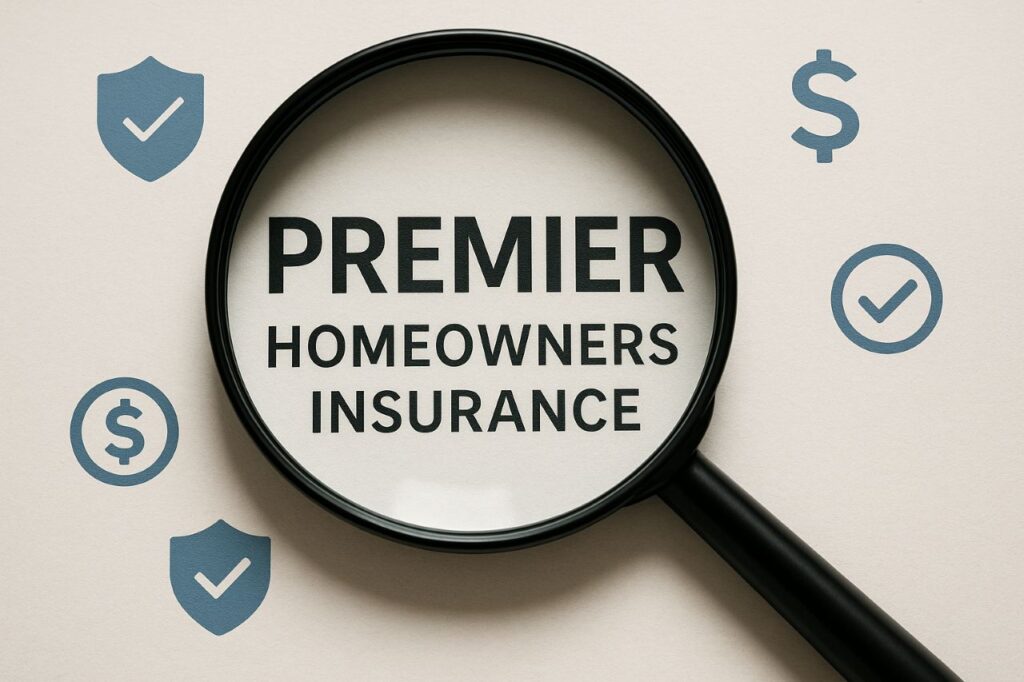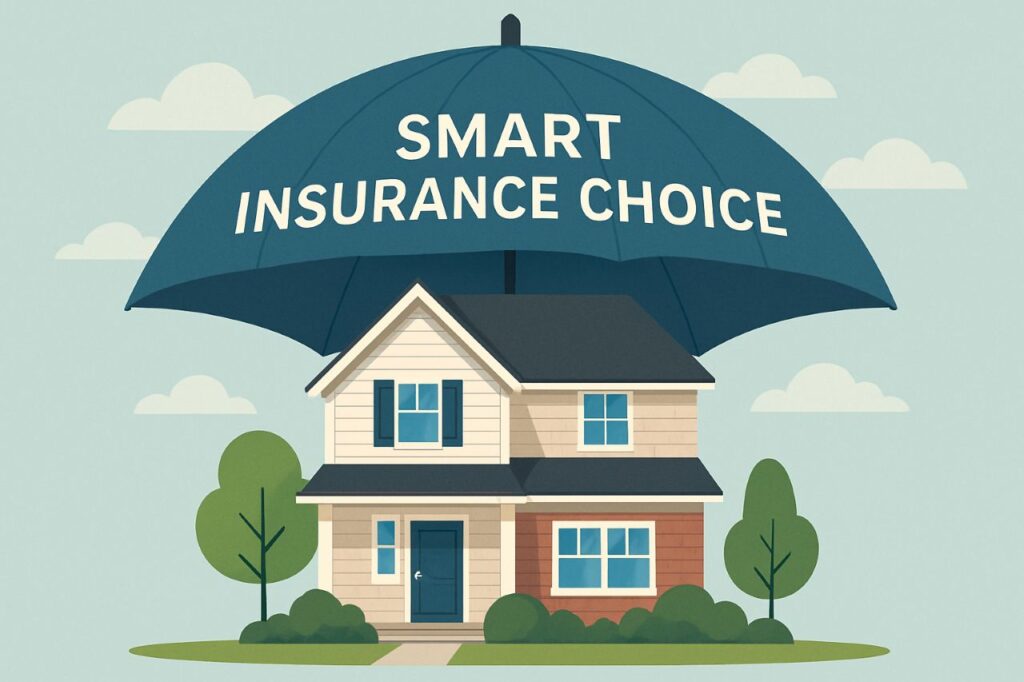Premier Home Insurance: 10 Shocking Facts You Need to Know
Premier Home Insurance provides more than minimum protection—it guarantees peace of mind, financial protection, and quality coverage for your home. But behind the guarantees, there are facts that every homeowner needs to be aware of. Some may shock you, but others may make you reassess your existing policy.
In this article, we reveal 10 surprising facts about Premier Home Insurance that speak to its positives and expose its secret negatives. Whether you’re purchasing a new policy or looking over an existing one, these facts will assist you in making a wiser choice. Let’s get started and find out what really makes it stand out.
Table of Contents
What is Premier Home Insurance?

Premier home insurance is a more advanced type of homeowners insurance, commonly advertised with better benefits, greater coverage limits, and additional features. These plans typically have other protections like identity theft coverage, increased personal liability limits, and guaranteed replacement cost on your house. However, it’s important to remember that not all Premier policies are the same.
Insurance companies such as State Farm and Allstate provide top-of-the-line levels of home insurance, sometimes at a higher price. They are marketing to homeowners who have valuable properties or want extra coverage beyond basic protection. But it’s important to check what’s in the fine print beyond the label.
How Premier Home Insurance Compares to Standard Policies
Knowing how Premier Home Insurance compares with regular homeowners insurance is crucial when making an educated decision. While both forms of coverage are meant to safeguard your property and possessions, the breadth and adaptability of protection differs significantly.
- Coverage Scope and Limits: Classic home insurance covers common perils like fire, theft, and certain weather damage. Premier policies, on the other hand, add these coverages to include greater limits and wider scope. For example, Premier policies usually cover protection against identity theft, service line failures, and loss of high-value personal property, all of which are not typically covered in classic policies.
- Replacement Cost vs. Actual Cash Value: One of the most important differences is how each policy treats replacement. Typical policies might only provide actual cash value (ACV), which takes depreciation into account. Premier policies usually come with guaranteed replacement cost, which means they’ll pay the entire cost of rebuilding your home to its original design, even if prices have increased because of inflation or supply chain disruptions.
- Personal Property Coverage: Premier policies usually provide much higher sub-limits for personal items. Basic policies may limit jewelry coverage to $1,000–$2,000 unless endorsed separately. Premier policies, however, may cover $5,000–$10,000 or more without needing a separate rider.
- Claims Process and Service Level: Premier Home Insurance tends to include priority claims handling, concierge-level service, and access to expert claims adjusters. Standard policyholders, on the other hand, may experience longer wait times, generic service, and additional paperwork.
- Optional Add-Ons and Bundles: Although both Premier and standard policies have optional endorsements, Premier policies can include some select add-ons as part of the policy or provide them at a discount. For example, water backup, cyber liability, or equipment breakdown coverage could be part of a Premier policy, while they’d be expensive additions to a standard policy.
- Value and Price: Naturally enough, Premier Home Insurance is more expensive. However, for owners of high-value items or specially designed homes, the extra premium is worth the cost for peace of mind and added financial security. If your home features special architectural elements, upscale furnishings, or contains a home office, Premier coverage could be the better value in the long run.
- Eligibility Standards: Not all homes are eligible for Premier coverage. Insurers tend to reserve such policies for high-value homes or those that meet certain standards. A new roof improved electrical systems, or valuable contents might be needed in order to qualify for these plans.
In short, Premier Home Insurance provides much stronger protection than basic policies but at a greater expense. Homeowners need to consider the worth of the additional coverage and service in relation to their individual risk profile and property value.
Tips for Choosing the Right Premier Home Insurance

1. Request a Full Breakdown of Coverage
Don’t rely solely on brochures or sales pitches. Ask your insurance provider for a detailed explanation of each section of the policy. This includes what’s covered, what’s not, how much you’re responsible for during a claim (deductibles), and any fine print clauses or exclusions. Some Premier policies may sound comprehensive but still exclude critical events like flooding or earthquakes unless specifically added. Getting it all in writing so you’re not surprised when you make a claim.
2. Compare Several Providers Before You Commit
Top home insurance policies vary significantly across providers in coverage, price, customer service, and extra benefits. Take the time to research your options with tools such as Policygenius or NerdWallet. These websites enable you to compare quotes side-by-side, read user reviews, and see which policies provide the best balance of value, protection, and customer satisfaction. Don’t settle for the biggest name — settle for the best fit for your home and lifestyle.
3. Look for Local Insurance Agents for Regional Know-How
Having a local agent does have its benefits, particularly in knowing local risks like wildfires, hurricanes, hailstorms, or even new local building codes. A local agent can also respond faster in emergencies and be more committed to settling your claims. They can provide a more tailored approach, suggesting coverage that national providers might miss due to the specific conditions in your location.
4. Adjust Your Coverage Periodically to Keep Up with Changes in Your Life
Your insurance requirements don’t stay the same. If you’ve remodeled your kitchen, added solar panels, finished your basement, or bought expensive furniture or electronics, every change increases the value of your house. If you don’t adjust your policy for these changes, you may be under-insured and have to absorb big losses yourself. Schedule a calendar reminder to check your policy once a year — or just after major home upgrades — to make sure your Premier policy remains full-coverage.
5. Double-Check What’s Really Included in “Premier” Plans
Don’t make the mistake that the term “Premier” implies “all inclusive.” Numerous high-end policies have optional endorsements or riders that need to include coverage for damage caused by water backup, recovery from identity theft, protection for high-value items, or equipment breakdown. Get a list from your insurer of typical inclusions vs. additional riders. You may be amazed at what is not included even in the highest-priced plans — and what further protection you truly require for comfort.
Common Mistakes to Avoid When Buying Premier Home Insurance
1. Assuming Coverage Is Unlimited for All Belongings
One of the most common errors that homeowners commit is assuming a “Premier” policy provides unlimited coverage, particularly for valuable items. Although the overall policy could carry a high limit of coverage, there are usually sub-limits for certain categories such as jewelry, electronics, art, collectibles, and firearms.
For instance, your coverage might limit jewelry to $2,500 despite a $500,000 personal property limit. To prevent under-insurance, ask for an itemized list of sub-limits and add scheduled personal property endorsements for items that fall outside of those limits.
2. Failing to Report Renovations or Home Businesses
Renovating your house or doing business in it can dramatically affect your coverage, and not informing your insurer can cause claims to be rejected. It doesn’t matter if it’s finishing your basement, adding a new room, or having a home-based business (such as a daycare or online business), these modifications change the risk profile of your home.
Most insurers mandate reporting such changes to ensure your coverage and premium value your home’s changed value and use. On occasion, there may be a need for a commercial rider or policy modification in order to sustain full coverage.
3. Not Bundling Policies for Optimum Discounts
Few homeowners fail to reap considerable savings by not bundling their Premier homeowners’ insurance with auto, umbrella, or other policies. Most insurers provide 10%–25% discounts for bundling, which not only lowers premiums but also makes it easier to make claims because there is one fewer provider to deal with.
If you’re purchasing Premier home insurance from an insurer that also provides auto or life insurance, inquire about bundling. Even if you’re satisfied with your current auto insurance policy, it can be worth reviewing bundled prices for long-term gains.
4. Disregarding Policy Changes and Renewal Alerts
Yet another frequent error is throwing renewal notices away without even reading them. Insurers consistently modify coverage provisions, deductibles, or premium levels based on claims experience, inflation, or local risk alterations.
Forgetting to update these policy conditions can give you less coverage, increased deductibles, or skipped endorsements. Be sure to examine your renewal paperwork carefully and get in touch with your agent if something appears incorrect or just isn’t normal for the current policy year. It may save you thousands later by making it worth a brief telephone call.”
10 Shocking Facts You Need to Know

Fact #1: Coverage Isn’t Always as Extensive as Advertised
One of the most alarming facts about Premier Home Insurance is that its title can be misleading. Although it guarantees greater coverage, numerous policies still have exclusions that are not known by homeowners until they are too late.
For instance, sewer backup or slow drips are not necessarily covered without certain endorsements. Some companies also have caps on mold damage or foundation work, even in top-tier policies. NAIC states that, unless items such as jewelry, paintings, or collectibles are listed, they could be partially or reimbursement under a claim—even those with a Premier label.
The bottom line? Carefully examine your policy materials in full and double-check which individual incidents and property types fall within your Premier coverage.
Fact #2: Premiums Can Fluctuate Heavily Based on ZIP Code
The ZIP code where your home is located has a lot to do with how much your Premier Home Insurance will cost. It isn’t merely based on the condition and value of the home—it depends on area-specific risk elements as well.
Residences located in California wildfire-risk areas or Florida hurricane-exposed coasts tend to cost much more than residences located in lower-risk regions. According to Policygenius, even city neighborhoods within the same area can have a 30%–40% rate disparity.
In addition, crime rates, proximity to firehouses, and rebuild costs within your neighborhood all contribute to your premium. Be sure to examine local statistics and ask insurers for breakdowns when comparing policies.
Fact #3: You Might Still Be Under-insured
Just because your home has a Premier label does not mean it is insured for its true replacement cost. A lot of homeowners incorrectly assume that their Premier Home Insurance covers them for full rebuilding value—but not always.
Regular coverage could be based on old appraisals or square footage, without taking into account renovations or inflation. The Insurance Information Institute cautions that under-insurance is still one of the most frequent errors—even among Premier policyholders.
To remain completely covered, have your home professionally valued and review your limits of coverage every year, particularly after renovations.
Fact #4: Certain Perks Only Exist with Add-Ons
Premier Home Insurance policies tend to tout amazing features—but most of those aren’t included automatically. Features such as service line protection, appliance failure, or personal cyber protection typically need additional endorsements.
You could be paying a higher premium thinking you’re covered, only to learn later that the most valuable features cost extra. Liberty Mutual and others list these as optional.
Ask for a clear itemized breakdown from your insurer. Confirm which features are included by default and what must be added separately.
Fact #5: Claims Process Might Not Be as Fast as Expected
Premier branding promises quicker service, but experience has been otherwise in many instances—even with luxury policies.
Disaster claims might swamp insurers and lead to processing delays. Reviews at Trustpilot and BBB indicate delays, incomprehensible document requirements, and even refusal to pay based on unclear policy conditions.
Always record incidents clearly and follow up regularly to minimize delays. And before selecting a provider, read genuine customer testimonials to measure true claims responsiveness.
Fact #6: Discounts Aren’t Always Automatic
Premier Home Insurance policies provide several discount opportunities—but they’re not automatic. Many homeowners believe they’re receiving all qualified discounts, but that’s typically not the reality.
According to NerdWallet, discounts for smart devices, loyalty, bundling, or claims-free history typically require direct inquiries. Providers rarely apply them retroactively.
During your quote or renewal process, explicitly ask for all eligible discounts. A five-minute conversation can save hundreds annually.
Fact #7: Coverage Limits for Personal Property Can Be Low
Premier policies may seem comprehensive but typically include high-value personal items with low sub-limits. Jewellery, musical instruments, collectibles, and professional tools usually need special scheduling.
Forbes Advisor points out that even in premier policies, individual valuables can have a minimum coverage of $1,500 unless they are disclosed and itemized.
In case your home has valuables worth more than these amounts, ask for rider coverage to make a complete claim after loss or theft.
Fact #8: It May Not Insure Your Home Business or Side Business
Home-based business owner? Your Premier Home Insurance probably won’t cover business property or liability related to that endeavor. This is an important omission for freelancers, online vendors, and home-based consultants.
The Hartford recommends adding a home business endorsement or commercial policy if your income pursuits pass hobby status.
Absent from it, a loss of a business nature—such as a fire destroying your stock or an injury to a client—can never be reimbursed.
Fact #9: Certain Natural Disasters Still Need Special Policies
Premier or otherwise, flood, earthquake, and sinkhole loss are usually not covered under regular policies. Additional insurance is needed for those hazards.
FloodSmart.gov explains that federal flood coverage is mandatory in high-risk areas and highly recommended elsewhere. Earthquake and sinkhole coverage will need to be added through individual riders, particularly for vulnerability states such as California or Florida.
Avoiding this can expose you to financial risk during disasters.
Fact #10: Not All Premier Policies Offer Guaranteed Replacement Cost
Most homeowners believe their Premier policy has guaranteed replacement cost—but they’re not always so fortunate. Some policies pay actual cash value (ACV), deducting for depreciation, or extended replacement, capping what they pay at a percent above insured value.
You can get guaranteed replacement as an add-on from Progressive and other insurers. Without it, reconstructing your house to its original quality might be the bill you’re stuck paying.
Request clear affirmations of your coverage type and think about bumping up to it if inflation or labor shortfalls could boost future rebuilding expense.
Success Stories: When Premier Home Insurance Delivered

Case 1: The Jameson Family, Colorado Springs
When a kitchen fire caused by an electrical failure occurred, the Jameson family’s Premier Home Insurance moved quickly into action. Within 48 hours of making a claim, an adjuster was sent to evaluate the damage. They were fully compensated for their kitchen renovation and 12 days of temporary housing, so they could concentrate on healing instead of paperwork.
Case 2: Maria Lopez, Austin, TXA
Windstorm struck Maria’s neighborhood with unexpected force, ripping shingles from her 25-year-old roof. Since her Premier policy came with guaranteed replacement cost, she didn’t merely receive the worth of her old roof—she was paid out for new, upgraded materials. The insurance company even paid to bring her house up to code.
Case 3: Kevin & Raj, Seattle, WA
The couple was the victim of a cyberattack that stole their identity and bank accounts. Fortunately, their Premier Home Insurance policy contained a cyber protection endorsement. Their insurer paid their legal consultation fee and cost of restoring their credit—more than $7,000 in damages—and identity theft monitoring services for one year.
These examples from everyday life emphasize the way that Premier Home Insurance can provide true value when matched to individual risk and properly known by the insured.
Final Thoughts
Premier Home Insurance might seem like the holy grail of insurance plans, delivering better coverage and peace of mind. Yet in reality, the best-sounding plans still contain restrictions, exceptions, and caveats that often surprise homeowners. Just because a plan has the word “Premier” slapped on it does not necessarily mean every eventuality is included — and guessing otherwise can be costly when surprises creep up in a claim.
By knowing the most frequent pitfalls and concealed details, you are able to make improved insurance choices. Utilize the information and advice in this guide as a checklist when purchasing, comparing, or renewing your Premier home insurance policy. Press your provider for the hard questions, scrutinize policy documents diligently, and never be afraid to ask for clarification.
Ultimately, your house is one of your most important investments — and it begins with protecting it by being informed. With the proper approach, Premier Home Insurance can provide great protection customized to your requirements, but only if you fully understand what you’re getting yourself into. In life, and in insurance, the fine print counts.
Read: Affordable and Reliable Home Insurance Newport Shropshire
Frequently Asked Questions
Is Premier Home Insurance worth it?
It can be, but only if you understand what’s included and ensure it meets your specific needs.
Does Premier Home Insurance cover floods?
No, you’ll need a separate flood policy from FloodSmart.gov.
Can I bundle Premier Home Insurance with auto coverage?
Yes, and you may receive a discount, but you must request it explicitly.
Are valuables fully covered in Premier plans?
Not always. Schedule high-value items for full protection.
How do I know if I’m under-insured?
Request a professional appraisal and review your coverage annually.
Does Premier Home Insurance cover home businesses?
Typically, no. You’ll need a separate business endorsement or policy to cover commercial activities conducted at home.
Is identity theft protection included in Premier policies?
Some Premier policies include this as an add-on. Confirm with your provider whether it’s included or requires an endorsement.
What happens if I don’t report home upgrades?
Unreported renovations can lead to under-insurance or denied claims. Always notify your insurer of major changes.
How fast is the claims process under Premier coverage?
While Premier policies aim for faster service, response times vary. Read consumer reviews and ask about average turnaround.
Can Premier policies be customized?
Yes. Most providers allow you to add endorsements for specific needs like water backup, cyber protection, or equipment breakdown.
Do Premier plans include temporary housing after a disaster?
Often, yes. Many include loss-of-use coverage, but limits may vary. Check the daily and total limits in your policy.
Are there any tax benefits to having Premier Home Insurance?
Generally, home insurance premiums are not tax-deductible unless the property is used for business. Always consult a tax advisor.








One Comment